Geographic Deaveraging
56. JC's deaveraging methodology ignores the natural breaks between low and high cost wire centers.
57. Verizon's deaveraging methodology minimizes the deviations in wire center costs.
58. When Verizon's deaveraging methodology is used, two wire centers show significantly higher costs than all other zones.
59. The zones adopted for interim rates do not match the zones adopted for permanent rates.
Billing Adjustment
60. To implement a "true-up" of interim rates, Verizon must calculate whether its interim rates are higher or lower than the rates adopted in this order, and whether it has over or under-collected the appropriate revenues for UNEs sold at interim rates.
Annual Reexamination
61. In D.99-11-050, the Commission established a process for the annual review of SBC's UNE rates.
Verizon Model
1. Verizon has not modeled a forward-looking network because it attempts to replicate the current network configuration, fails to economize by aggregating smaller distribution areas into larger ones, and does not efficiently size and deploy current technology.
2. Verizon's loop model contains anomalies in preprocessed input data which indicate multiple, overlapping facilities and distribution areas. These potential input errors raise doubt as to whether VzLoop accurately depicts the current local exchange network.
3. The lack of integration in the various modules of Verizon's model increases the likelihood of modeling duplicative facilities and makes it difficult to test input sensitivity.
4. Verizon's model contains many inputs and assumptions that are not forward-looking such as the FLC factor, GTD-5 switches, structure sharing, cost of capital and overhead markup.
5. It is unduly burdensome and unreasonable to use the Verizon model, which requires extensive and time-consuming manual manipulation and is prone to human error in the input modification process.
6. Verizon's FLC factor is circular because it creates a ratio that produces the level of forward-looking expenses that Verizon has determined are appropriate.
7. Verizon's FLC factor ignores the possibility that telecommunications technological advancements may reduce operations and maintenance expenses.
8. The GTD-5 switch is not a forward-looking switch technology.
9. The structure of Verizon's switching model makes it difficult to modify and test varying inputs.
HM 5.3
10. It would be inappropriate to rely on the rebuttal version of HM 5.3 because of the resources required to examine all modeling and algorithm changes that were not adequately described.
11. The customer location process in HM 5.3 creates distribution areas based on current population characteristics, unlike Verizon's model which makes no attempt to reconfigure distribution areas.
12. The customer location process in HM 5.3 is TELRIC compliant even if the reconstructed network does not follow Verizon's actual outside plant routes.
13. Both HM 5.3 and the Verizon model contain aspects of loop modeling that the Commission was unable to modify.
14. The fill factors in HM 53 can be adjusted to ensure reasonable excess capacity for short-term growth.
15. It is reasonable to rely on a model with larger clusters based on a forward-looking configuration using currently available technologies, rather than an approach that uses fixed distribution areas incapable of maximizing the efficiencies offered by forward-looking equipment.
16. Efficiency and productivity assumptions in HM 5.3 can be remedied with input changes such as revised labor costs, structure sharing percentages, and switching inputs.
17. It is inappropriate to compare HM 5.3 modeling results to Verizon's current expense and investment levels.
18. HM 5.3 allows the user to make modifications, implement them quickly, and consistently replicate the results in a reasonable time frame with a high degree of certainty.
19. It is reasonable to use a model with some flaws when the alternative is another flawed model that is difficult to operate and modify.
Asset Lives
20. It is unreasonable to rely on asset lives the FCC prescribed in 1996 for Contel, given the competitive and technological developments since that time.
21. Verizon's proposed asset lives are supported by the study of its witness Sovereign, similar to those adopted for SBC, and should be used in the Commission's HM 5.3 model run.
Cost of Capital
22. The Commission should ignore Verizon's proposed cost of equity because Verizon fails to justify why a proxy group of non-telecommunications firms has a similar risk profile and growth forecast as a telecommunications firm.
23. It is reasonable to use an 12.3% cost of equity to set Verizon's cost of capital based on JC's CAPM analysis and our analysis of SBC's cost of equity with a revised beta of 1.0.
24. A 6.15% debt cost based on Moody's A-rated industrial bonds is reasonable because the term of this debt is similar to the asset life assumptions incorporated into the Commission's model runs.
25. It is reasonable to assume a forward-looking capital structure of 66% equity and 34% debt, based on averaging market value and book value information for a proxy group of companies, particularly since this capital structure comports with the target capital structures of other telecommunications utilities.
26. The risk of providing UNEs is no greater than Verizon's retail risk because Verizon does not have to incur sunk investments solely for UNE purposes.
27. Verizon's proposed risk adder should be rejected because quantitative models, such as CAPM, reasonably capture investor's views of the risks facing Verizon in the UNE market.
IDLC/UDLC
28. The Commission should adopt an assumption of 90% IDLC and 10% UDLC, as proposed by Verizon, because UDLC may be required until operational issues with IDLC are resolved.
Fill Factors
29. A copper distribution fill factor of 52% is reasonable because it reserves close to 50% of copper lines as spare capacity at a time when wireless substitution indicates less demand for access lines.
30. A fiber feeder fill factor of approximately 80% is reasonable, based on an assumption of four fibers per DLC site.
31. The copper feeder fill factor proposed by JC is reasonable and should be adopted. The DLC fill factors in HM5.3 should be adjusted to account for inventory management and installation constraints, similar to the adjustments in D.04-09-063.
32. It is reasonable to assume a 2-pair NID for premise terminations, along with increases to the labor assumptions for NID installation.
33. JC's proposed SAI fill factors are reasonable and should be adopted.
Structure Sharing
34. It is reasonable to adopt structure sharing input percentages identical to those we relied on in D.04-09-063 when setting UNE rates for SBC.
Plant Mix
35. JC's proposed plant mix assumptions are reasonable because they are based on current information provided by Verizon.
DLC Costs
36. It is reasonable to use DLC costs developed for SBC in D.04-09-063 as modeling inputs because Verizon's data is nationwide and JC's inputs were previously rejected. It is reasonable to use SBC costs as a proxy because SBC and Verizon are similarly-sized ILECs operating in the same state, facing similar labor markets. Verizon's data unreasonably assumes installation cost is directly related to material cost and may not be based on the correct DLC equipment.
Labor Costs
37. The Commission should run HM 5.3 with certain categories of labor inputs proposed by Verizon, rather than the labor rates and crew sizes proposed by JC that were rejected in D.04-09-063.
Maximum Copper Loop Length
38. We should assume a maximum copper loop length of 12,000 feet in our model runs for the reasons articulated in D.04-09-063.
Switching Inputs
39. For switching inputs, the Commission's model run should assume a mix of 36% new and 64% growth switch purchases based on Verizon's purchases over the last five years.
40. The Commission should rely on the price per line proposed by JC because Verizon's price per line is dominated by GTD-5 switch purchases and we have found the GTD-5 is not a forward-looking switch.
41. A flat-rated port pricing structure is more representative of the way Verizon incurs switch costs.
42. It is reasonable to adopt a flat-rated port pricing structure, similar to the one adopted in D.04-09-063, because Verizon's switch processor utilization data indicates a low probability of switch exhaust.
High Capacity Loops and Transport
43. Verizon's transport and high capacity loop modeling is unreasonable because it produces rates significantly higher than current rates when industry trends indicate declining costs for these facilities.
44. The updated inputs for high capacity loops and transport in the rebuttal version of HM 5.3 are reasonably based on Verizon data and responsive to Verizon criticism. These updated inputs should be incorporated into the Commission's model run using the earlier filed version of HM 5.3.
45. Verizon's proposed interoffice rate design, which involves fixed and usage-based charges, is reasonable and consistent with the approach adopted for SBC.
Shared and Common Cost Markup
46. Verizon does not adequately explain its forward-looking expense adjustments that flow into its markup calculations and does not adequately show that retail, non-recurring, and non-UNE costs are removed.
47. The 8.93% markup proposed by JC is reasonable because it is based on Verizon California data and excludes retail, non-recurring, and non-UNE costs.
Price Floors
48. Switching should no longer be classified as a monopoly building block when calculating price floors because competitors have the ability to duplicate switching facilities to serve customers.
49. The Commission should not use Verizon's price floor proposals if it rejects the Verizon model, and its inputs and assumptions, for UNE costing purposes.
50. In D.04-11-022, the Commission maintains consistency with the principles of IRD and does not override the MBBs prescribed in D.99-11-050.
51. MCI's proposal to treat all UNEs as MBBs should be rejected, consistent with D.99-11-050 and recent FCC actions refining unbundling requirements.
52. Verizon should calculate price floors using the methodology approved in D.03-03-033, except Verizon should substitute into its calculations the UNE rate adopted in this order for the loop MBB and reduce its volume sensitive TSLRIC for loops by 17.1%.
Geographic Deaveraging
53. When creating geographically deaveraged zone rates, two high cost wire centers should be isolated into a fourth rate zone.
54. Verizon and other parties should propose a method for implementing billing adjustments given that the interim and permanent rate zones are not identical.
Annual Reexamination
55. The Commission should establish a procedure for reexamination of Verizon's UNE rates in the next phase of this proceeding by considering CALTEL's price cap proposal, the adoption of a procedure similar to the one established in Ordering Paragraph 11 of D.99-11-050, or the use of updated inputs and assumption to the HM 5.3 model.
56. The Commission should not reexamine the UNEs adopted in this order before February 2008.
IT IS ORDERED that:
1. The recurring prices for unbundled network elements (UNEs) offered by Verizon California (Verizon) that are set forth in Appendices A and B to this decision satisfy the requirements of Sections 251(c)(2), 251(c)(3), and 252(d)(1) of the Telecommunications Act of 1996 and are hereby adopted.
2. Pursuant to Commission Resolution ALJ-181 (adopted October 5, 2000), Verizon shall prepare amendments to all interconnection agreements between itself and other carriers. Such amendments shall substitute the recurring UNE prices set forth in Appendices A and B for the UNE prices set forth in such interconnection agreements. Such amendments shall be filed with the Commission's Telecommunications Division, pursuant to the advice letter process set forth in Rules 6.1 and 6.2 of Resolution ALJ-181, within 30 days after the effective date of this order. The amendments do not require a signature of the carriers involved as long as the amendments are limited to substituting the UNE rates adopted in today's order. Unless protested, such amendments shall become effective 30 days after filing. The flat per port switching rates adopted in this order shall not apply in the context of reciprocal compensation between carriers. The rates shown in Appendix B shall be used for reciprocal compensation purposes.
3. The UNE prices adopted in this order shall be effective on the date this order is effective. Verizon shall make all billing adjustments necessary to ensure that this effective date is accurately reflected in bills applicable to these UNEs. Verizon shall have 60 days from the date of this order to complete the billing program changes necessary to reflect in bills the recurring prices for UNEs adopted in this order. Upon completion of said billing program changes, Verizon shall notify the Director of the Telecommunications Division in writing that all of the necessary billing program changes have been completed.
4. Within 90 days of the effective date of this order, Verizon shall calculate any billing adjustments owed to or by interconnecting carriers based on the modification of interim rates originally established in Decisions (D.) 03-03-033 and D.05-01-057 to the rates in this order, but payment of any billing adjustments, or "true-up," is stayed pending the outcome of further proceedings in this docket to consider payment options or other mitigations to lessen any negative effects of the true-up. The administrative law judge shall issue a ruling within 30 days of this order setting a prehearing conference to initiate these proceedings.
5. CALTEL's November 22, 2005 motion for consideration of a process for future modification of Verizon UNE rates is granted in part. The Commission shall establish a procedure for reexamination of Verizon's UNE rates in the next phase of this proceeding by considering CALTEL's price cap proposal, the adoption of a procedure similar to the one established in Ordering Paragraph 11 of D.99-11-050, or the use of updated inputs and assumptions to the HM 5.3 model. The Commission shall not reexamine the UNE rates adopted in this order before February 2008.
6. Verizon's petition to modify D.99-11-050 and remove switching as a monopoly building block in the price floor calculation is granted.
7. Within 30 days of the effective date of this order, Verizon shall file an advice letter calculating its Category II price floors as set forth in this order. Verizon's compliance advice letter shall include workpapers that show how it has derived its price floors. This advice letter shall be subject to protest in accordance with General Order 96-A.
8. This proceeding shall remain open pending resolution of true-up payment issues and consideration of a procedure for reexamination of the UNE rates adopted in this order.
9. The motion to intervene filed by Cbeyond Communications LLC is granted.
This order is effective today.
Dated March 15, 2006, at San Francisco, California.
MICHAEL R. PEEVEY
President
GEOFFREY F. BROWN
DIAN M. GRUENEICH
JOHN A. BOHN
RACHELLE B. CHONG
Commissioners
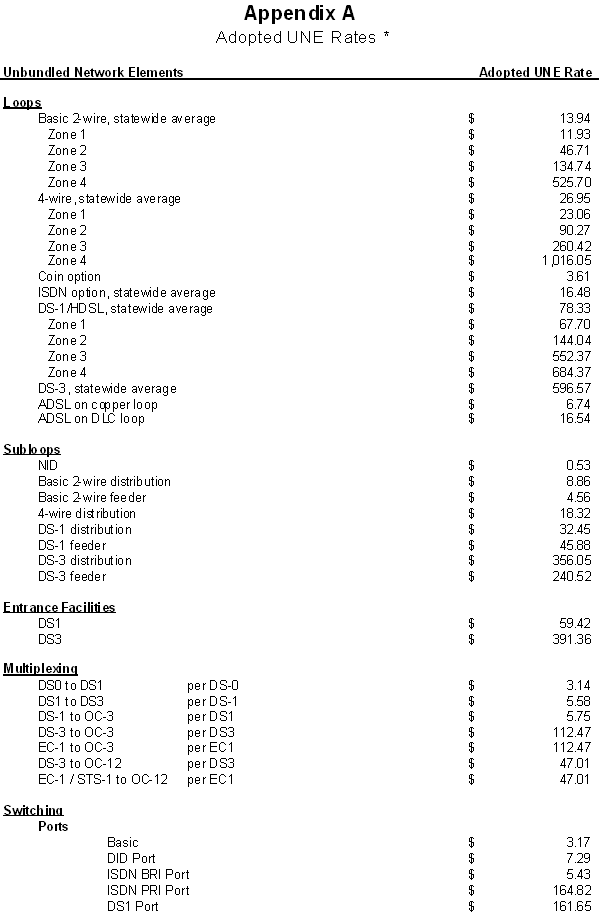
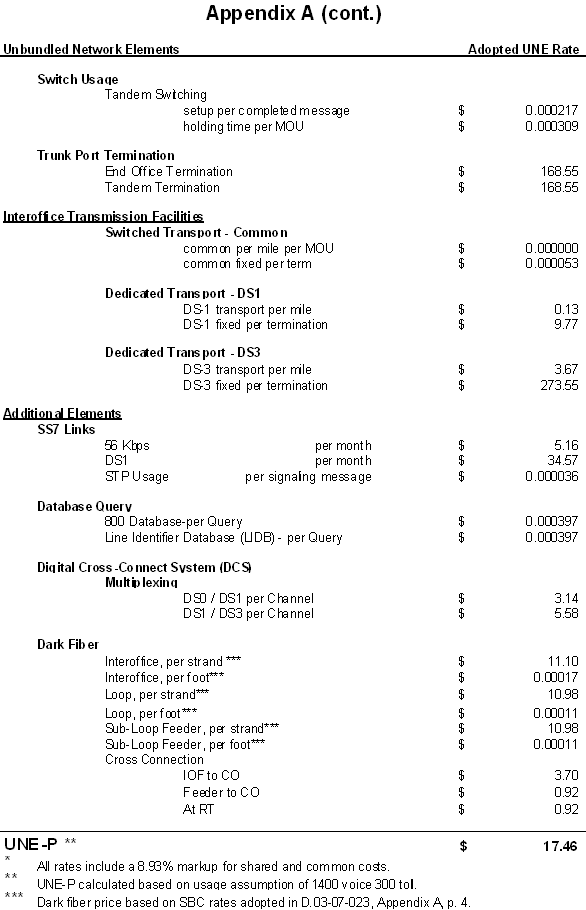
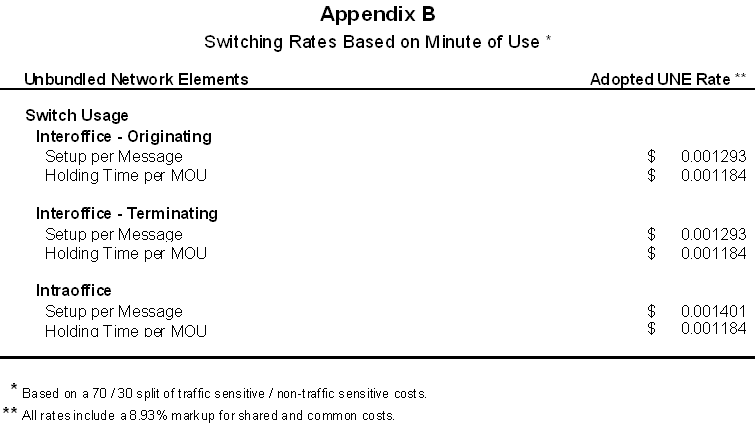
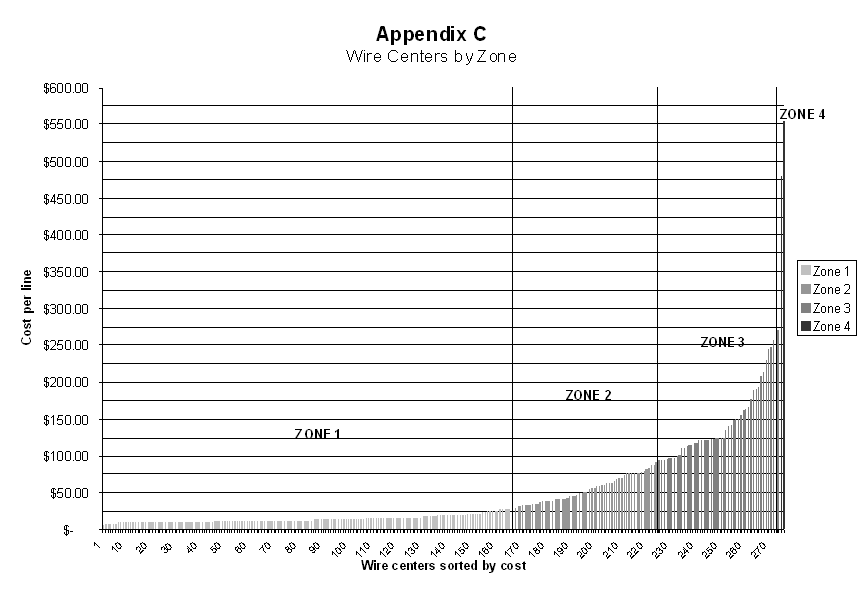
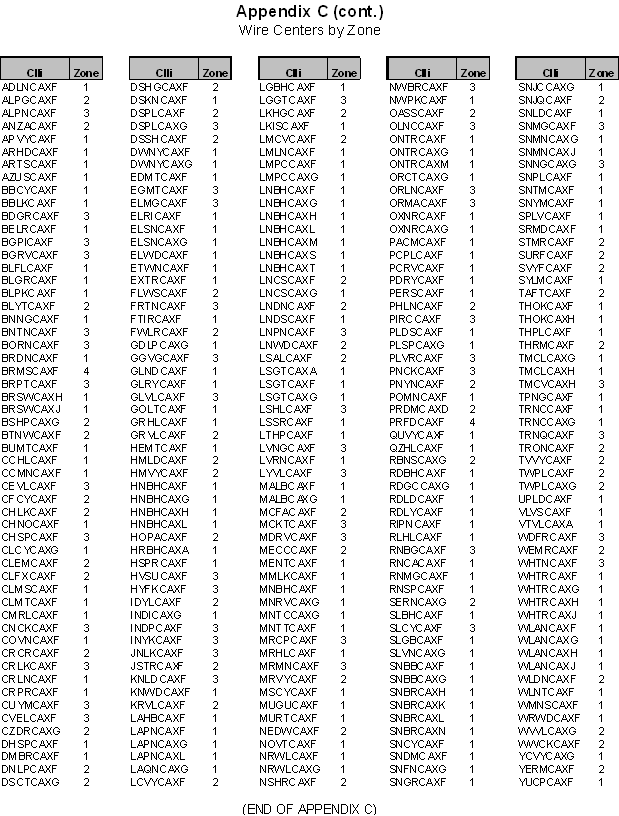
Appendix D
ACF Annual cost factor
ARMIS Automated Reporting Management Information System
CAPM Capital asset pricing model
CCPs Consensus Costing Principles
CEV Controlled environmental vault
CLC Competitive local exchange carrier
DA Distribution area
DCF Discounted cash flow
DLC Digital loop carrier
DSL Digital subscriber line
ECRIS Engineering Construction Records Information System
FCC Federal Communications Commission
HM 5.3 HAI Model, Version 5.3
IDLC Integrated digital loop carrier
ILEC Incumbent local exchange carrier
IOF Interoffice facilities
MBB Monopoly Building Block
NID Network interface device
NRF New Regulatory Framework
OANAD Commission Rulemaking 94-04-003 regarding "Open Access and Network Architecture Development"
POTS Plain old telephone service
RBOC regional bell operating company
ROE return on equity
RT Remote terminal
SAI Serving area interface
SS7 Signaling System 7
TELRIC Total element long run incremental cost methodology
TSLRIC Total service long run incremental cost methodology
TNS Taylor Nelson Sofres
TRO FCC's Triennial Review Order
TRRO FCC's Triennial Review Remand Order
UDLC Universal digital loop carrier
UNE Unbundled network element
UNE-P Unbundled network element platform
VGE voice grade equivalent
(End of Appendix D)
APPENDIX E
LIST OF APPEARANCES
Respondents: Elaine Duncan, and Rudolph M. Reyes, Attorneys at Law, for Verizon California, Inc.; Preston Gates Ellis & Rouvelas Meeds LLP, by Christopher S. Huther and Megan H. Troy, Attorneys at Law for Verizon California, Inc.; Wilmer Cutler Pickering Hale and Dorr LLP, by Catherine Kane Ronis and William R. Richardson, Jr., Attorneys at Law for Verizon California, Inc.
Interested Parties: Regina Costa, Representative, and Christine Mailloux, Attorney at Law, for The Utility Reform Network; David Discher, Attorney at Law, for SBC California; Joseph S. Faber, Attorney at Law, for California Association of Competitive Telephone Companies; William C. Harrelson, Attorney at Law, for MCI, Inc.; Richard E. Heatter, Representative, and Marilyn H. Ash, Attorney at Law, for Mpower Communications Corp.; Kimberly M. Kirby, Attorney at Law, for Cbyond Communications LLC; David J. Miller, Attorney at Law, for AT&T Communications of California, Inc.; Katherine Mudge, Attorney at Law, for Covad Communications Company; Earl Nicholas Selby and Michael A. Morris, Attorneys at Law, for XO California, Inc.; Terrance A. Spann, Attorney at Law, for United States Department of Defense and All Other Federal Executive Agencies; Glenn Stover, Attorney at Law, for Anew Telecommunications Corporation and Navigator Telecommunications, LLC;
Office of Ratepayer Advocates: Natalie Billingsley, Representative, and Natalie D. Wales, Attorney at Law.
(End of Appendix E)


